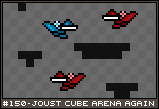| Three Hundred |
| - Index Page |
| - About... |
| - By Year |
| Collections |
| - Comp-Grid |
| - Procedural |
| - Tactics |
| - Tiny Crawl |
| - Misc |
| Previous | Mechanic #150 | Next |
This entry represents the halfway point for the Three Hundred project, and as such, I've decided to go back and revisit one of the weaker entries from the project's past, [#062 - Joust Cube Arena]. The idea was not completely without merit, but it could be improved immeasurably by, first, simplifying it, and second, finding a way to connect the gameplay gimmick with actual gameplay. The premise is simplified a little bit here, being a Joust-like game of arial lance poking that takes place in a 2D environment instead of a 3D one. Also, instead of the terrain being impressed upon the cube walls, the game is made of multiple geometric shapes that have the terrain already baked in. And finally, this is a single player game rather than a multiplayer arena combat game.
![[joust1.png]](set08/img/entry150-joust1.png)
There's really two parts to this equation. The first part, is that you are essentially playing Joust inside of an enclosed arena. This arena will move and rotate, and it is up to you (and your enemy) to navigate and battle while this is happening.
![[joust2.png]](set08/img/entry150-joust2.png)
The second half of the equation is that the arena itself is part of a larger level, and the thing that causes it to shift and rotate are the things that it encounters as it moves through it. For instance, it might be sliding along, all happy and stuff, then hit a rock, causing it to tumble forward - rotating until it has done a full 90 degree clockwise rotation - and then continuing on.
![[joust3.png]](set08/img/entry150-joust3.png)
Things in the environment will also affect the arenas. When the arena is floating in water, the lower portion of the arena will likewise be submerged. Similarly, if an arena moves underneath a lava flow, lava will pour into the arena, leaving lava pools behind (see fig 150.3). And, of course, if the arena should rotate, the lava would pour out as the gravity changes. A similar idea are eggs that hatch into enemies whenever they are right side up, causing enemies to appear as the arenas rotate. There should be different ways for the arenas to travel through the larger environments that can be controlled somewhat by the player inside the arena. Maybe the player can cause a rotations to happen by smacking into the side of the arena - depending on which side is on the bottom when the arena falls into water, it may float on top or sink to the bottom. Or the mass of the arena could include the number of players and enemies inside it, thus flying a different distance when it slides down a cliff into a ski jump.
![[joust4.png]](set08/img/entry150-joust4.png)
As arenas are moving through these environments, they may run directly into another waiting arena. When this happens, the arenas connect for a brief period of time, allowing the player to enter the new arena. After this period, the old arena fades away (destroying any enemies still inside it) and the new arena starts moving forward through the environment.
![[joust5.png]](set08/img/entry150-joust5.png)
Finally, arenas are by no means always square. They can be circular, hexagonal, rectangular, trapezoidal, or whatever other shape. Each shape will affect how the arena can travel through the environment, as well as the physics of rotation and manipulating the travel path.
|
